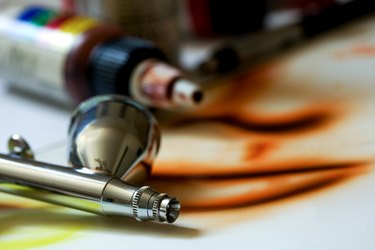
Airbrushing is a fantastic technique to use for a wide variety of arts and crafts projects, but it does come with a learning curve. One aspect of airbrush painting that takes some experimentation is picking the right paints to use. Acrylic craft paint is a popular choice, but its consistency varies from brand to brand, and it usually needs to be thinned before it's suitable for airbrushing. Thinning acrylic paint for airbrushing takes a little trial and error, but it's easy to do.
Using Acrylic Airbrush Paints
Video of the Day
Acrylic paints specially formulated for use in an airbrush are available from art stores and well-stocked craft stores. These are the best choice if you want to use acrylic paints for airbrushing, as they have a fine pigment and a thin consistency. This means the paints pass easily through the fine nozzles of an airbrush without risk of clogging and give good-looking, long-lasting results to a painted project.
Video of the Day
Some artists find that acrylic airbrush paints do require a little thinning depending on the brand of paint and the needs of the particular art project. Still, starting with acrylic airbrush paints is always the best choice.
Using Acrylic Craft Paints
Regular acrylic craft paints can be suitable for airbrushing, but they are too thick to be used straight from the bottle. Thinning acrylic paint for airbrushing is essential, but you should understand that the results might not be quite as nice as the results achieved with special acrylic airbrush paints. The pigment particles in acrylic craft paints aren't as fine as those in acrylic airbrush paint and have the potential to clog an airbrush. However, many users find that thinning acrylic paint for airbrushing meets their needs and budget.
Thinners You Can Use
Thinning acrylic paint for airbrushing is easy to do, but it takes a little experimentation to figure out the right ratio of paint to thinner. The best thinner to use is acrylic paint thinning fluid, which you can buy from art supply and craft stores. Look for the same brand of thinner as the brand of paints you're using. There are also DIY recipes available online for making acrylic paint thinner from various household supplies.
Alternatively, you can use distilled water to thin acrylic paint for airbrushing. Don't use tap water, as its minerals and impurities can result in poor paint coverage and clogging issues. Some artists report that cracking of dried paint can be an issue when you thin acrylic paint with distilled water, so a commercial thinning fluid is usually a better choice.
Thinning Acrylic Craft Paint for Airbrushing
Thinning acrylic paint for airbrushing is as simple as blending paint and thinner together, whether it's in a small container with a paintbrush or by shaking the liquids together in a sealed container. Aim for the consistency of skim milk and adjust as necessary after trying the thinned paint in your airbrush. Start with a ratio of 1:1 paint to thinner and use a small amount of each to avoid waste while you're in the experimenting stage.
If you want to be exact, carefully weigh or measure the paints and thinner. Note the measurements, ratios and how you like the results of airbrushing with the thinned paint. This way, you can establish an ideal ratio of paint to thinner to use for future projects. That ideal ratio will probably be different for each brand of acrylic craft paint.